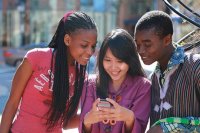The Digital Lives of Teens: Code Switching
Recently, NPR launched a new blog entitled Code Switch to examine the "frontiers of race, culture and ethnicity." Blog host Gene Demby explains: "We're looking at code switching a little more broadly. Many of us subtly, reflexively change the way we express ourselves all the time. We're hop-scotching between different cultural and linguistic spaces and different parts of our own identities -- sometimes within a single interaction."
Daily, teens confront the challenges and opportunities of code switching in digital spaces, at home and at school. Code switching is not easy to do and can bring coping fatigue, confusion, missteps and distractions.
One Kid, Many Languages
The rules of the game of digital engagement vary from one space to the next. At school, often no cell phone use is permitted during the school day. Yet the moment a student steps foot off campus, texting begins. Literally, the switch is turned on, and linguistic patterns shift to abbreviated, often indecipherable text-speak. Then, in the same breath, an adult approaches a teen -- maybe a parent, guardian or coach -- and the teen code switches from phone language to face-to-face conversation, utilizing a different set of speech patterns and tones.
In classrooms, code switching presents challenges in working with teens, who have a hard time moving out of established patterns of communication cemented at home and with peers outside of school. For example, during class project work time on a device like a laptop or iPad, a student veers off topic to find a silly video he had seen at home. The student does what he would do at home or with his friends -- he emails the video to a friend. At home and with his friends, this is the behavioral norm. But at school, this behavior is not acceptable and breaches classroom norms of engagement, focus and community. Yet the student is confused, having acted on impulse, forgetting the classroom "code." To go back to Gene Demby's explanation, the student has "reflexively" changed the way he expresses himself in the classroom.
Software entrepreneur Russ Warner taps into the many ways that teens code switch or "hide" their online behaviors from adults. In a Huffington Post blog, he catalogues teen behaviors like clearing browser histories, adjusting privacy settings, using proxy sites, and creating "duplicate or fake" social network profiles. The bottom line: teens feel the need to code switch in front of adults to mask digital speech and linguistic patterns.
Present Shock
Teens are living a new presentist, non-linear narrative, as Douglas Rushkoff notes in his new book, Present Shock: When Everything Happens Now. This is most evident in how teens consume and watch media: through mash-ups, "cutscenes" on YouTube, reality TV and gaming. Teens are taking over the narrative, becoming "the equivalent of storytellers. Snowboarders score their own paths down a slope, while skateboarders reinterpret the urban landscape as an obstacle course." Teens are turning to "computers and games to choose their own adventures and find their own answers."
Rushkoff goes on to note: "Which flashing screen we choose to answer often means less about whom or what we want to engage with than who or what we want to be, ourselves, in that moment. We're in the game, all right, but playing on many different levels at once." This is the new digital code that young people are growing up with.
Yet school functions in a linear fashion, with clearly demarcated lines of progression from one grade level to the next and one assignment to the next. While kids are able to create their own narrative outside of school, they find themselves having to code switch back to school. In schools, tension arises between digital presentism and linear learning approaches. Essentially, there is a struggle over who controls the narrative -- the student or the teacher.
Adapting the Classroom Code
However, it is not a zero sum game. Instead, students and teachers can work together to create a shared narrative. By better understanding the digital code switch, teachers can find suitable and appropriate entry points for student learning, engagement and ownership of the narrative.
How can teachers share the narrative with students?
- Provide choice within projects. One student might write a poem, another might write a short story, yet another might write a graphic novel.
- Give students the opportunity to share. This might involve sharing a song they write in music class on SoundCloud, or posting on a class blog, or collaborating on a Google Document.
- Try backchannel chatting in class through a tool like TodaysMeet.
- Create classroom norms for digital spaces. For example, define norms of behavior for using online forums, like blogs, chats and documents. Have the students generate the list of acceptable behaviors, and be open about the challenges of code switching from virtual gaming environments like Minecraft to classroom spaces.
- Create levels of learning and mastery to mirror gaming environments that are built on failure, perseverance and the determination to level up.
- Acknowledge that students want to have ownership of the narrative, and have an open conversation about digital "code switching" to find out from students what is appealing about the different learning spaces they are engaged in. See if there is a meeting point that allows students to bring some of what they love about these other, outside of school digital spaces into the classroom.
